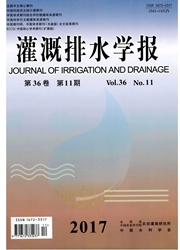

 中文摘要:
中文摘要:
采用盆栽试验,设置4个旱涝交替胁迫处理f旱.涝.旱连续胁迫,涝后水分自然落干,待达到水分控制下限后开始旱胁迫:分蘖期:涝为保持水深10cm,包括轻旱(T-LD)和重旱(T-HD)2个处理:拔节期:涝为保持水深15cm。包括轻旱(S-LD)和重旱(S.HD)2个处理],并以常规灌溉(CK)为对照,研究了不同生育期(分蘖期和拔节期)旱涝交替胁迫条件下水稻茎节发育状况和茎秆抗倒伏能力,并分析了茎节、株高、倒伏指数、抗折力之间的相关关系。结果表明,旱涝交替胁迫后,拔节后期和黄熟期水稻第一、二、三茎节生长发育均受到抑制。拔节后期各处理株高显著低于CK,且第-茎节S内较CK降低了20.84%~39.07%;而黄熟期T.LD、T-HD处理株高却超过CK,且T-LD和T-HD处理第一茎节S外、S内均较CK显著降低,而S—HD处理第一茎节S自较CK显著降低了69.70%,S#较CK显著增加了34.78%。拔节后期和黄熟期水稻各茎节长度相互之间呈显著正相关(p〈0.01),且第二茎节长度与第三茎节相关系数最高。但各茎节长度与株高相关性较弱;另外,株高的增加不利于水稻抗倒伏。黄熟期水稻第一茎节s。与倒伏指数显著正相关,而与抗折力负相关,第四茎节S外与倒伏指数显著负相关,与抗折力显著正相关。第一、二茎节S外和S截的增加不利于水稻抗倒伏,第三、四茎节截面积的增加有利于水稻抗倒伏。
 英文摘要:
英文摘要:
Pot experiments were performed to research the stem growth and lodging resistance of rice under alter- native stress of drought and waterlogging (ASDW) at the tillering and jointing stage, and the relationships be- tween stem, plant height, lodging index, bending force were analyzed; four treatments were set up (the tillering stage: light drought (T-LD) and severe drought (T-HD); the jointing stage: light drought (S-LD) and severe drought (S-HD) using regular irrigation (CK) as the control (Drought-light waterlogging-drought continuous stress, the water depth of waterlogging was 10 cm and 15 cm at the tillering stage and j ointing stage). The results showed that at thi jointing stage and ripening stage, the growths of first, second, third rice stem section were in- hibited. At the jointing stage, plant height of all treatments were significantly lower than that of CK and the first stem elliptic cross-sectional area was reduced by 20.84% ~39.07% compared with CK. At the ripening stage, plant heights of T-LD, T-HD treatments were higher than CK and the first stem elliptic cross-sectional and outer cross-sectional area of T-LD, T-HD treatments decreased significantly compared with CK; the first stem elliptic cross-sectional area of S-HD treatment was significantly reduced by 69.70%, but the stem section area was signif- icantly increased by 34.78% compared to CK. At the jointing stage and ripening stage, internode length showed significant positive correlation (p〈0.01) between all stems, and the correlation coefficient of the second and the third internode was the highest, but the internode length had a weak correlation with plant height; in addition, plant height increment was not conducive to lodging resistance of rice. At the ripeness stage, the first stem elliptic out cross-sectional area had a significant positive correlation with lodging index, and had a negative correlation with bending force; the fourth stem section area was significantly negatively correlated with lod
 同期刊论文项目
同期刊论文项目
 同项目期刊论文
同项目期刊论文
 期刊信息
期刊信息
